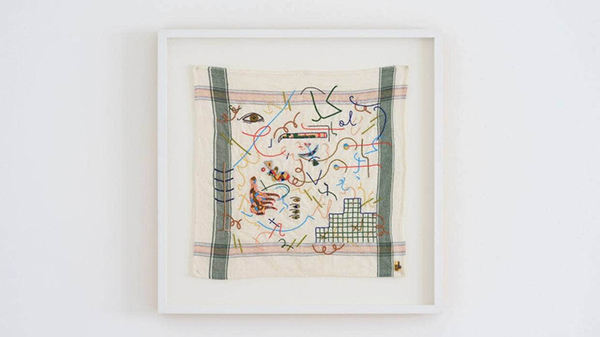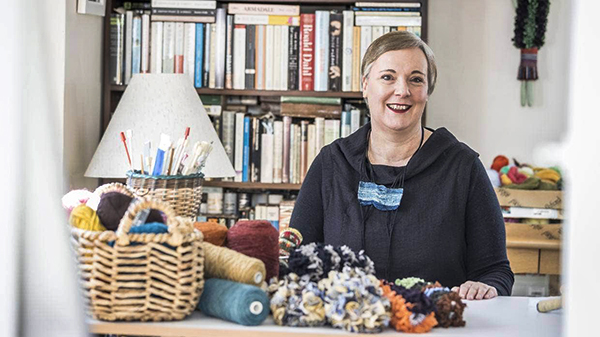Work by Caroline McQuarrie and Lizzy Leckie in She Shed at Petone Settlers Museum.
Mark Amery, Te Hīkoi Toi: Nice threads, Stuff, 19 March 2022
Mark Amery salutes the Threads Textiles Festival, an impressive programme of textile arts on as part of Aotearoa New Zealand Festival of the Arts.
The Petone foreshore is a good place to start stringing together a history of Aotearoa’s textiles. The first thread runs from the mouth of Te Awa Kairangi (Hutt) River to Korokoro Stream. flowing out of the bush.
This was, until 1968, site of the Petone Woollen

We now import a flood of sustainably-questionable cheap textiles, but handwoven techniques continue to be handed down, increasingly picked up by new generations, strengthening connections to the past. Artists are increasingly “picking up the threads”, exploring the political and cultural resonances of a material with strong domestic and industrial histories in relation to their own whakapapa. And in doing so, recognising the complexity of Aotearoa’s cultural makeup today.
Threads Textiles does a beautiful job of illustrating all this. Its quality and range are made possible through collectivity, as curators and gallerists together up their game around a timely theme, often opening up to new artists.


On the foreshore is the Petone Settlers Museum. It’s a building commemorating Māori meeting the first ship carrying British settlers to Wellington in 1840. Thus, here two strong textile traditions meet.
Sitting ingeniously in the frame of a garden shed among displays of local industry, She Shed is the Dowse 2021 Blumhardt curator Dr Bronwyn Lloyd’s tribute to wool craft heritage and the unsung women who powered that industry.
Seven contemporary makers offer different responses building on their heritages, with craft often passed down from mothers and grandmothers. Vita Cochran even discovered that three great-aunts worked at the Petone mill, emigrating from Manchester’s woollen mills.

Caroline McQuarrie’s blanket evokes those made famously at the mill, with on one “public” side a Petone logo emblazoned with stitched depictions of the buildings and activity – as you might imagine a commemorative tea towel – while on the other a personal, imagined diary entry of a worker, sensually evoking the sight and sounds in the mill and outside solace on the hill.
She Shed connects us richly to nature. Lizzy Leckie’s throws use natural dyes made from diverse plants from her immediate Kūaotunu environment on the Coromandel peninsula, while Daegan Wells’ wool is sourced from his pets, along with harakeke from a local historic mill and stones from his Colac Bay, Southland, beach. Georgina May Young’s seed pouches depict the flora and waters that once fed the mill at Korokoro stream.

Creating a small open room within a closed one, She Shed is beautifully designed, demonstrating the potential with hung, draped and laid textiles for a 360-degree viewed conversation between artists and their surrounds.
The Hutt’s industrial heritage has been recognised in an applied arts focus at the Dowse since its establishment 50 years ago.
There, we’re taken back to the 1970s by a knock-out exhibition of Central Otago farmer Eden Hore’s collection of couture gowns – remarkable today in the richness of colour, pattern and material.
Among them the thick woollen dresses of Beverley Horne (not exactly light, I’m reminded of the ambassadorial robes of a planetary culture from a 1960s episode of Star Trek).
Upstairs The Silk Web presents a pop take on Central Asian textile traditions, commenting on our global capitalist meltdown, from Silk Road countries Azerbaijan, Uzbekistan and Kazakhstan.

I’ve got round a few excellent Threads Texiles exhibitions.
For those Covid nervous, I recommend the windows of Ghuznee St, beginning with Josephine Cachemaille’s shrine to women gardeners at Service Depot, Matthew McIntyre-Wilson’s nodding harakeke fish nets, recovering historic knotting techniques in the Bowen Galleries window, and The See Here’s Greta Menzies banner paying homage to sun, moon and plants.
In Victoria St, Avid’s windows afford views of all 45 stunning kete woven by Jo Torr and Tarryn Motutere from the 208 Māori weaving patterns collected in Mick Pendergrast’s book Raranga Whakairo.
Next door in the Page Galleries window, Fiona Jack’s embroidered text banner ‘Existential Doom’, speaks with verve to the prevailing mood on the street. She is part of Soft Landings, an excellent survey of different approaches to textiles.

Raised in Mumbai and Howick, Areez Katki is from a Parsi Indian family with its own rich distinct traditions. Deeply engaged in this heritage and ways to express a vibrant assimilated present, Katki was taught to sew by his mother and grandmother.
His vibrant alive embroideries at McLeavey Gallery are stitched into boldly repurposed inherited textiles, loaded with memories and migratory stories. There are a grandfather’s khadi handkerchiefs and prayer shirts, fragments from a grandmother’s clothing and 1940s tea towels.
Recalling the late Wellington embroiderer Gordon Crook, Katki opens out the potential pluralities of line, with a calligraphic abstract dance of squiggles and shapes in a rebellious rainbow of colour. Creating new visual poetic codes he explores the fluid complexion of a sense of place, with his inheritance as playmat.
The embroidery is like a breezy, electric shorthand of written impressions, both embedded in his own history, but open for all to take these lines and make stories. Katki both sophisticatedly and playfully extends the free possibilities of language to reflect multiplicity and zest for life.

Threads Textiles Festival until March 20. She Shed, Petone Settlers Museum, until October 16. Eden Hore, Dowse Art Museum, until March 20. Areez Katki, McLeavey Gallery, until April 9.

